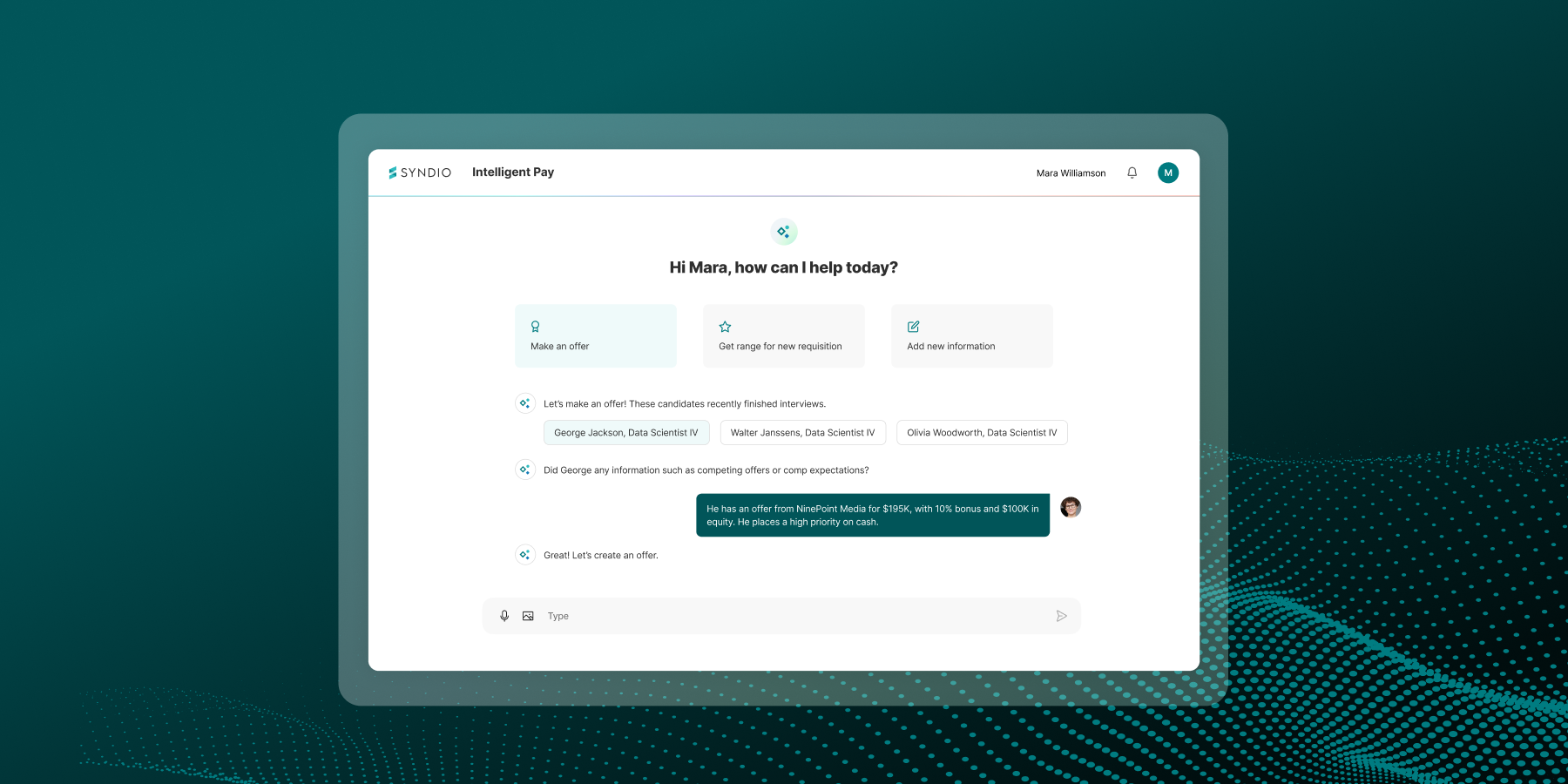 Our recent webinar, The Fight for Talent: How Workplace Equity Can Help You Win, featured two industry leaders discussing their strategies for attracting and retaining top talent with workplace equity in the midst of the current fight for talent. Connie Kielty, VP of Compensation for QBE North America, and Jennifer Shenker, Head of People Rewards, Analytics and Operations for Asana, joined Katie Bardaro, Syndio’s Chief Revenue Officer, for a live Q&A session. These are some of the highlights from the conversation.
Our recent webinar, The Fight for Talent: How Workplace Equity Can Help You Win, featured two industry leaders discussing their strategies for attracting and retaining top talent with workplace equity in the midst of the current fight for talent. Connie Kielty, VP of Compensation for QBE North America, and Jennifer Shenker, Head of People Rewards, Analytics and Operations for Asana, joined Katie Bardaro, Syndio’s Chief Revenue Officer, for a live Q&A session. These are some of the highlights from the conversation.
First, can you describe the pay equity journeys that your organizations have taken?
Connie explained that QBE’s pay equity journey began in 2016, saying it has evolved significantly since. QBE began looking just at the average pay of men and women by their internal leveling and grading system, along with comparing the average merit increase for men and women. After several years working with a consultancy that manually analyzed pay equity on behalf of QBE, the team began working with Syndio in the first quarter of 2021. According to Connie, Syndio’s platform made it possible to look at pay equity more frequently and for more demographic groups.
“With the addition of Syndio, we feel we now have access to the technology we need to specifically analyze pay equity for gender and ethnicity multiple times per year.”
Asana has also been on their pay equity journey for several years, Jennifer said. When she started with the company three years ago, they employed 400 people and are now over 2,000, making it a very dynamic environment.
“I knew that one of the top priorities would be to implement a regression-based, kind of gold standard pay equity analysis,” Jennifer explained. “The reason that we went with Syndio is we wanted to have this be part of our regular ongoing comp processes. We wanted to be able to look at this within the pay process itself and make pay changes as part of that cycle that were necessary to maintain equity. And so we did that in 2020.”
What advice would you give about how to win this war for talent and maintain workplace equity?
“Lean on your culture,” Jennifer said. “I think it’s been important for us. Pay is important — and you have to be in the mix, for sure — but you’re also not always going to be able to match the top offers.
“Play for the long term.”
“And the other thing that I would say is play for the long term. It’s very easy to make decisions for the short term, but if you really want to win on equity, you have to keep the long-term goals in mind and be willing to take some hits in the short term for that long-term goal and measure over a long time period.”
How are you preparing for the new pay transparency laws being passed in many states? What information are you planning to share externally vs. internally?
Because QBE has a large population in New York and California where more transparent laws are being enacted, Connie used those states as an example for QBE’s approach. She said that in the next two weeks they were going to display the minimum and maximum of the pay range on every open requisition internally and externally .
“Since we have people in so many states, probably all but five or six states, we are going to do it across the US.”
Connie also said they would probably send out some manager communications, employee communication, and FAQs the following week.
Jennifer added that Asana was following a very similar path.
“Most people don’t have incentives at Asana, but have base salary plus equity. And because of the way that we’ve evolved — we recently went public — a lot of longer tenure employees had pre-IPO equity, which is worth quite a bit now. We had some variability in the payments; maybe we had an engineer with longer tenure who might have had a lower salary, but their equity was worth a lot more. So there may be a difference in that payment.
“Knowing that transparency was going to be coming, we started to take more aggressive action to bring more parity to the different components of the payment.
“So that’s something structurally that we’re doing not only in anticipation of the transparency laws, but related to our overall evolution. It definitely is helpful because it creates fewer questions. It’s always been something that we’ve been really clear about, but given that we’re only going to be transparent with our salary ranges and not the total compensation ranges, we felt it was important to try to bring those closer together.”
How do you communicate your pay equity results to employees?
Jennifer reported that every time they do the work, she holds a 1-hour session with employees to discuss the results. She said that she tries to ground their pay equity work within Asana’s broader diversity strategy.
“There were [initially] a lot of questions, a lot of skepticism about the process.”
“The first couple of times I did this, I wouldn’t say it was contentious, but there were a lot of questions, a lot of skepticism about the process.”
Jennifer explained that she and her team really invested in trying to help people understand the methodology and to understand “some of the pitfalls of just looking at data and not really seeing the full story.” They use illustrative examples, she added, and have employees interact during the process by giving their feedback about what they think would be fair controls that could be applied. They really educate people on the actual methodology used, she said.
“I go into a little bit of back and forth with the participants,” she said. “I put up a bunch of factors, and I ask, ‘Hey, do you think it’s fair to pay a software engineer differently based on these different factors?’ I offer one who lives in Vancouver versus one who’s in New York City. And then I go through a bunch of different factors.
“Of course, there are some people who don’t agree that it is fair to pay someone differently. And geography, that’s one that’s commonly a bit more controversial. But for the most part, most employees are aligned that these are reasonable reasons to pay a differentiated way.
“I also talk about some other ways that data can be misleading or difficult to compare across organizations. And so it really allows us to have a good conversation about why we focus on the adjusted pay gap rather than the raw pay gap. We do report out on both, though.
“In terms of the methodology, we actually co-present with a Syndio partner, who explains regression analysis and the P values and the stoplight methodology that Syndio uses. But I go through the controls and the methodology around how we’re calculating compensation, the controls that we’re using, the SSGs, the groupings that we’re using.
“And then we do present the results. We share both our adjusted pay gap and our raw pay gap. We don’t show the actual underlying data, but we do show some examples of a scatter plot.
“So it is quite in depth and we spent a lot of time developing it and kind of pacing the conversation. We give them a preview of the data up front, but we say, ‘Hey, you’re going to have a lot of questions. We’re going to dig into the methodology, please bear with us.’
“We’ve been doing this for a couple of years now, and in the most recent one that we did, it was interesting because while it was well attended, there were not a lot of questions. So I think we’ve done a good job in educating people, and now they’re really there to see the results, hear the story behind the results and how they’re changing.”
What changes are you planning to make to your compensation programs or practices in the future?
“What I’d really like to focus on at some point in the next year is trying to get Pay Finder™ as part of our toolkit as well,” Connie said. “We have fairly broad salary ranges and we’d like to make sure when we’re on-boarding people, we’re bringing them in at the beginning at the right salary and providing our recruiters with a little bit narrower salary range to use so it won’t disrupt any of our potential pay equity positioning.”
“What we’re looking at going forward for the next cycle is we want to continuously be looking at our groupings, because we’re evolving rapidly,” Jennifer said. “We want to make sure that those job changes and role changes are reflected in our groupings.”
“We’re looking to do some more sophisticated analysis of career equity.”
“We’re also looking to make sure that we’re tying our outcomes to our broader diversity, inclusion and belonging strategy,” Jennifer explained.
“And then we’ve been moderating our headcount growth. We’ve been growing really at a rocket
pace and given the economic uncertainty, we are going to moderate that going forward. So making sure that we’re recalibrating our representation goals, which had a certain amount of growth built in and then messaging that to employees, is another thing that’s top of mind for us.”
What advice would you share with an organization that’s just starting its pay equity journey? Anything that you learned that would help people start faster?
Connie said that QBE had a really good experience with a consultancy that helped them develop a strategy and principles around multi-regression analysis review and get a cadence for doing pay equity analysis on a regular basis.
“But I would probably go right to Syndio,” Connie added. “It’s very easy to set up and implement. Bringing it in house in our control was kind of life changing for us.”
“I would probably go right to Syndio.”
“If you have an HRS system where you can easily get comprehensive employee files and data reports, you can just snap your fingers and load it into Syndio,” Connie added.
Jennifer said that her biggest recommendation would be “to really ground your pay philosophy, and be really thoughtful about all the decisions you make around methodology. And related to that, I think you definitely need, unless you’re an expert in this area, the help of a really strong external partner. Or multiple external partners.
Asana worked with a team that included consultants, a data scientist at Syndio, and an outside counsel, Jennifer explained. “All of those different perspectives, I think, really helped us to develop a defensible methodology that we could explain and that we could evolve over time. But that was grounded in the philosophy.
“I think that if you try to just get the tool and do it yourself, you might miss some of the important decisions that could really impact your results or your findings and the value that you’re getting out of the work that you’re doing, because the value here is really trying to uncover potential bias and remediate it,” Jennifer said.
“So getting that external partnership and getting all the stakeholders together so that you can have a lot of different perspectives and make sure people are all aligned, I think is very important, that would be probably my biggest advice,” Jennifer concluded.
Want more?
Workplace equity can be a valuable tool for attracting and retaining top talent, but achieving and maintaining equity while in the midst of that fight for talent is a challenge. As QBE and Asana are demonstrating, though, it can be done. These are just a few highlights from the discussion – watch the on-demand recording for more.
The information provided herein does not, and is not intended to, constitute legal advice. All information, content, and materials are provided for general informational purposes only.



